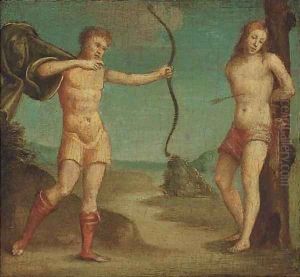Giovanni Battista Caroto Paintings
Giovanni Battista Caroto was an Italian painter of the Renaissance period, born in Verona in 1480. He was a prominent figure in the Veronese school of painting, which flourished in the 15th and 16th centuries, contributing significantly to the development of the Renaissance art movement in northern Italy. Caroto's work is characterized by its vibrant color, meticulous attention to detail, and the emotional depth of its subjects. His style reflects the influence of his contemporaries and predecessors, including Mantegna and Bellini, yet his work also displays a distinct personal touch that distinguishes it within the rich tapestry of Renaissance art.
Caroto was apprenticed early in his career to Liberale da Verona, a well-regarded painter of the time, which provided him with a solid foundation in the techniques and styles prevalent in the early Renaissance. He later worked alongside Francesco Morone, further refining his skill and developing his own artistic voice. Over time, Caroto's work began to exhibit a greater sense of emotion and a deeper exploration of human expression, traits that would come to define his mature style.
Throughout his career, Caroto was commissioned to work on a variety of projects, including altarpieces, frescoes, and portraits, demonstrating his versatility as an artist. His religious paintings, in particular, are noted for their emotional intensity and the humanity of their figures, bringing biblical stories to life with a remarkable sense of immediacy. Caroto's portraits are equally significant, celebrated for their psychological depth and the skillful depiction of individual character.
Caroto's legacy extends beyond his contributions to the canon of Renaissance art. He was also a teacher, influencing the next generation of Veronese painters. His influence is evident in the works of his pupils, who continued to propagate the stylistic and thematic elements characteristic of his work. Giovanni Battista Caroto died in Verona in 1555, leaving behind a body of work that continues to be studied and admired for its beauty, emotional depth, and technical mastery. His paintings remain on display in many of the world's leading museums, attesting to his enduring significance in the history of art.
